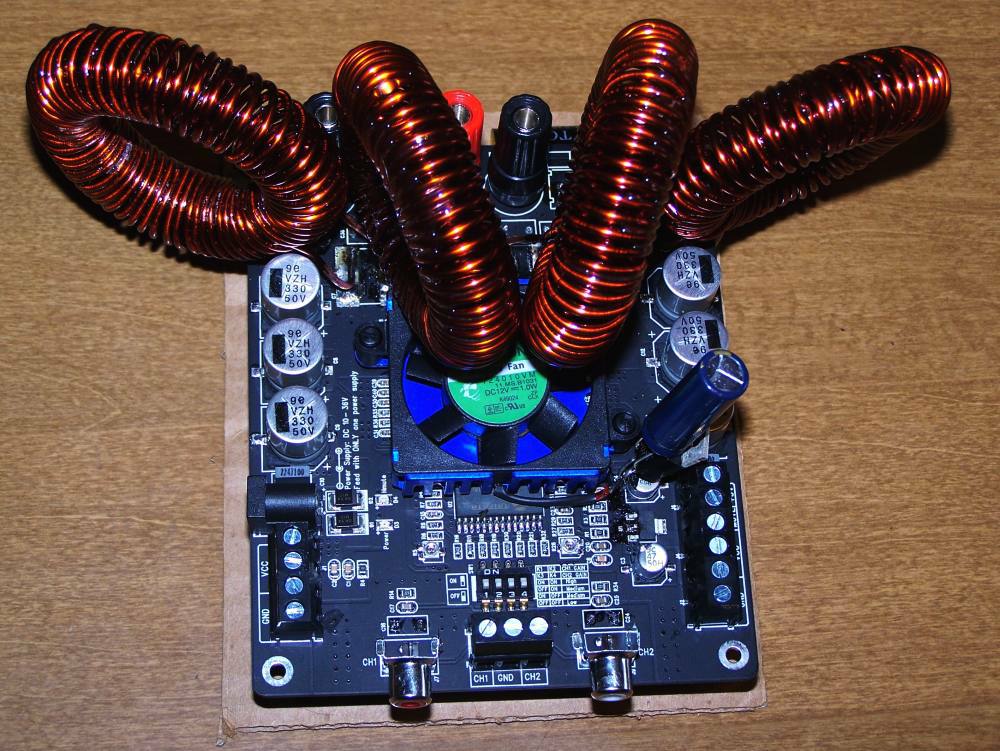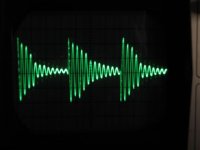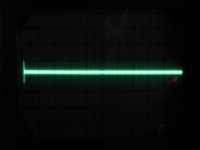He is right however you will generally gain more by paralleling caps of different values. If you hang a 1000+uf on there also parallel it with a .1uf poly cap. I have yet to see anyone here do this and it's very commonly done in high end amp power supplies.
You may be right on the board. Seems like the actual pins on these chips vaporize indicatring they can't even handle the currents involved!!
Mark
You may be right on the board. Seems like the actual pins on these chips vaporize indicatring they can't even handle the currents involved!!
Mark
Same road
Now you see the same road that I am on. I am truly surprised that there is no consensus or recommendation for class D coils. Not even an argument like there is with caps. Apparently not very many people have ever tried to listen to different coils even though every class D amp has them. I have started threads just to ask about that and the only answer forth coming was the 10uH Arjen coils on Ebay which are a good price. I ended up winding my own for now on T106-2 cores from Partsandkits.com. This weekend I will install the 6uH air core toroids I wound to see if they still have the air core magic with the lower emissions of a toroid.Would these inductors work well to build the new output filter circuit? They are Coilcraft RFB1010 Series Power Inductors Specs are... 10 µH 0.023 DC res. 23 mhz SRF 6.10 Amps
Linky Dinky: Coilcraft RFB1010 Leaded Power Inductors
Thanks in advance for any advice... there is such a plethora of inductors out there I don't know where to start looking...
Mark
Why such a large value for the rail caps. I currently have 2000uf. What gains are made by adding more?
My scope told me so. I use the Mean Well S-145-24 SMPS and it does show some switching patterns. With the capacitance I can swamp those to some extent.
Also the other way round, I can see less of the bass make its way through to the PSU. So I figured more is betterer.
Btw I recommend to connect COM to GND on the PSU. Otherwise it shows awful noises on its output.
He is right however you will generally gain more by paralleling caps of different values. If you hang a 1000+uf on there also parallel it with a .1uf poly cap. I have yet to see anyone here do this and it's very commonly done in high end amp power supplies.
There are 0.22uF film caps on board. I didn't bother to change those. I think Audio1st reported that he had a go at them.
The schematic says they are MKP.
Btw I recommend to connect COM to GND on the PSU. Otherwise it shows awful noises on its output.
Do you mean the ground (of the AC input terminals) and the COM (of the DC output terminals) on the Mean Well itself?
I have the same Mean Well PSU and I want to make sure that I am following your instruction correctly before I blow anything up.
There are 0.22uF film caps on board. I didn't bother to change those. I think Audio1st reported that he had a go at them.
The schematic says they are MKP.
I have been wondering about these caps ever since I noticed them while I was upgrading the power caps.
What do they do and how do I determine the capacitance to be used?
Can I try something other than 0.22uF?
Do you mean the ground (of the AC input terminals) and the COM (of the DC output terminals) on the Mean Well itself?
I have the same Mean Well PSU and I want to make sure that I am following your instruction correctly before I blow anything up.
I have a short wire bridge btn the GND terminal and the COM terminal on the PSU. But you can ground the DC-COM anywhere in your setup I guess, if it is more favorable to avoid ground loops or anything.
These are not instructions, I just report what I have done and can recommend. My observation is only that is not a good idea to leave the COM floating against GND.
So maybe you want to report back when you did it. Just so we know you have not blown up...
I have been wondering about these caps ever since I noticed them while I was upgrading the power caps.
What do they do and how do I determine the capacitance to be used?
Can I try something other than 0.22uF?
These are bypass caps, go google.
Electrolytics are good at removing low frequency ripple from the supply voltage, especially since they come with large capacitances. Film caps are better at filtering high frequency ripple (lower ESR), but they come in smaller capacitances. That's why they are used in parallel.
Yes, you can try something else. In fact, you can try anything else as long as you obey the voltage ratings.
I have a short wire bridge btn the GND terminal and the COM terminal on the PSU. But you can ground the DC-COM anywhere in your setup I guess, if it is more favorable to avoid ground loops or anything.
These are not instructions, I just report what I have done and can recommend. My observation is only that is not a good idea to leave the COM floating against GND.
So maybe you want to report back when you did it. Just so we know you have not blown up...
I just tested bridging the ground terminal and COM terminal on the PSU with a short wire. I am happy to report that nothing is blown and everything works as usual
To be honest, I don't hear any difference, but I will keep the wire there and do further monitoring.
BTW, where I live, all the wall sockets are without ground connections. Wall sockets have only two holes, for neutral and live, I guess. So basically the ground wire from the PSU is going nowhere and floating in the air! I haven't suffered from electricity shocks in my time in this room, but I am just wondering whether not having a proper grounding on the mains can cause some problems to the amplifier. I would appreciate any comments on this.
I thought I share this with you:
Mean Well S145-24 with some 10mF and a 0.39 Ohm resistor in series with floating COM, picture taken at 20mV/div and 5us/div compared to COM tied to GND, at 5mV/div and 5us/div.
And I can hear this with a B1 buffer in front of the amp.
Mean Well S145-24 with some 10mF and a 0.39 Ohm resistor in series with floating COM, picture taken at 20mV/div and 5us/div compared to COM tied to GND, at 5mV/div and 5us/div.
And I can hear this with a B1 buffer in front of the amp.
Attachments
I haven't suffered from electricity shocks in my time in this room, but I am just wondering whether not having a proper grounding on the mains can cause some problems to the amplifier. I would appreciate any comments on this.
Yes, you're right, hot and neutral are the two wires that's powering your gear. The third ground wire is purely a safety feature. If you have a fault that creates a short in your equipment, you would a have dangerous situation. Nothing to do with equipment performance, everything to do with not getting electrocuted.
Last edited:
I thought I share this with you:
Mean Well S145-24 with some 10mF and a 0.39 Ohm resistor in series with floating COM, picture taken at 20mV/div and 5us/div compared to COM tied to GND, at 5mV/div and 5us/div.
And I can hear this with a B1 buffer in front of the amp.
A few people earlier in this thread were bad-mouthing using battery power. After seeing this, I wonder. I was using a battery to power the updated SI amp, and the improvement in sound was dramatic. Right now I'm using a 15V 20A linear P.S. favored by ham radio operators. It has a low level mechanical hum in the transformer that drives me crazy when the ambient noise level in my room is very low. Back to the battery, methinks.
Now you see the same road that I am on. I am truly surprised that there is no consensus or recommendation for class D coils.
Exactly! I think most here are missing the boat to be honest. Those coils and the Zobel are probably going to make the biggest difference sound wise o0n any class D amp. The input cap on this amp as well. Other then that small mods can be done that most here probably couldn't tell any difference or not. You still need an unmodified amp to compare any mods done too!!
Mark
Exactly! I think most here are missing the boat to be honest. Those coils and the Zobel are probably going to make the biggest difference sound wise o0n any class D amp. The input cap on this amp as well. Other then that small mods can be done that most here probably couldn't tell any difference or not. You still need an unmodified amp to compare any mods done too!!
Mark
The 41hz forum has a lot of discussions about toroids and inductors. Doesn't seem like any one type stands out but MPP is mentioned as a possible step up...
Excellent MeanWell power supplies
When operating at their best, The MeanWell power supplies paint a pretty picture. I don't think a battery would look much better than your second screenshot.
.I thought I share this with you:
Mean Well S145-24 with some 10mF and a 0.39 Ohm resistor in series with floating COM, picture taken at 20mV/div and 5us/div compared to COM tied to GND, at 5mV/div and 5us/div.
And I can hear this with a B1 buffer in front of the amp.
When operating at their best, The MeanWell power supplies paint a pretty picture. I don't think a battery would look much better than your second screenshot.
Hi All,
I've been following this thread and I'm very intrigued by the "Sure" boards. I purchased the 2* 100w board which I received yesterday and plan on doing some mods as time permits. My question is could you use an adjustable DC-DC up convert on the power supply? I have a 27vdc/13ah smps coming and I'm wondering if this is possible. Also the o/p inductors on my board are marked DR127-220, when googled I find they're made by "Coiltronics" a division of Cooper/Bussman and are available at Digi-Key. Here's some specs. INDUCTOR SHIELD PWR 22UH SMD - DR127-220-R
My board also has a fan on the H/S and I received a free fan also. This should be a fun project. Good luck to all on your mods and thanks much to all that have given such great advice on how to get the most out of this board.
This should be a fun project. Good luck to all on your mods and thanks much to all that have given such great advice on how to get the most out of this board.
Dan
I've been following this thread and I'm very intrigued by the "Sure" boards. I purchased the 2* 100w board which I received yesterday and plan on doing some mods as time permits. My question is could you use an adjustable DC-DC up convert on the power supply? I have a 27vdc/13ah smps coming and I'm wondering if this is possible. Also the o/p inductors on my board are marked DR127-220, when googled I find they're made by "Coiltronics" a division of Cooper/Bussman and are available at Digi-Key. Here's some specs. INDUCTOR SHIELD PWR 22UH SMD - DR127-220-R
My board also has a fan on the H/S and I received a free fan also.
Dan
Best ever
The new 14ga. air core toroids are playing and they sound better than the previous 20ga. cylindrical air cores which were already intriguing me. The toroids do exhibit much better EMI containment although not quite as good as the T106-2 cores which also leak a little more noise than the original little shielded bobbins. Long story short. This is the best sounding amp I have ever had home. Explosive dynamics with see through detail in a jet black background. And it runs off of a single $32.00 supply. I am now a true believer in the Tripath technology. Too bad they went out of business. Next up, some 14ga. Litz wire.
.

The new 14ga. air core toroids are playing and they sound better than the previous 20ga. cylindrical air cores which were already intriguing me. The toroids do exhibit much better EMI containment although not quite as good as the T106-2 cores which also leak a little more noise than the original little shielded bobbins. Long story short. This is the best sounding amp I have ever had home. Explosive dynamics with see through detail in a jet black background. And it runs off of a single $32.00 supply. I am now a true believer in the Tripath technology. Too bad they went out of business. Next up, some 14ga. Litz wire.
.

The new 14ga. air core toroids are playing and they sound better than the previous 20ga. cylindrical air cores which were already intriguing me. The toroids do exhibit much better EMI containment although not quite as good as the T106-2 cores which also leak a little more noise than the original little shielded bobbins. Long story short. This is the best sounding amp I have ever had home. Explosive dynamics with see through detail in a jet black background. And it runs off of a single $32.00 supply. I am now a true believer in the Tripath technology. Too bad they went out of business. Next up, some 14ga. Litz wire.
.

Thanks for the update sendler. Maybe I missed a post earlier but are these self-wound or did you buy them?
- Status
- This old topic is closed. If you want to reopen this topic, contact a moderator using the "Report Post" button.
- Home
- Amplifiers
- Class D
- Sure Electronics New Tripath Board tc2000+tp2050

